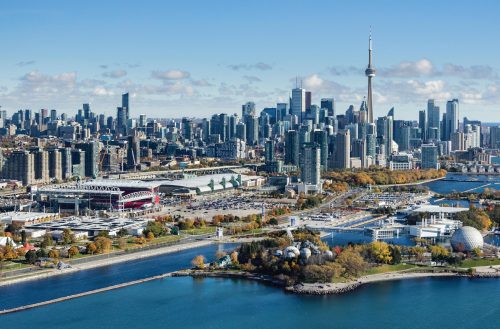
Exhibition Place located at 2 Strachan Avenue, is owned by the City of Toronto and managed by a Board of Governors, and contains:

Exhibition Place is a special and unique waterfront asset located in the City of Toronto. It hosts over 350 events a year and attracts 5.3 million visitors annually. It is a visually prominent site defined by iconic entrances, connected to a network of waterfront attractions and is well known to Torontonians and people all across the province and country. It is also a place that through its history, has presented opportunities to its site planners, users, and city inhabitants. It has showcased critical periods and crowning achievements in Toronto’s history, and which are also significant within the Province of Ontario.
It is a place nestled on the north shore of Lake Ontario that would have attracted Indigenous populations. It is the site where the French chose to establish a defensive and commercial fort in the 1700s. It is here that the British sought to expand their defensive position on Lake Ontario in the mid-1800s. It has also been the place where the city and the province created a hub to promote agricultural education and excellence beginning in the nineteenth century. This site then became a place for making grand gestures when it hosted the Provincial Agricultural Fair in 1878 and was then selected in 1879 to annually host the Toronto Industrial Exhibition. Beginning in the early twentieth century, and continuing until the 1970s, site organizers embarked on ambitious building programs that would support the site’s permanent and continued use as the Canadian National Exhibition and the Royal Agricultural Winter Fair. The complexes and features established during this period signaled that Toronto and Ontario’s capital had become a world class and cosmopolitan city.
The City of Toronto retained Archaeological Services Inc. (A.S.I.) in collaboration with Brown + Storey Architects to prepare a Cultural Heritage Landscape Assessment of Exhibition Place to appropriately identify and assess the site’s cultural heritage resources, including its cultural heritage landscapes and archaeological resources. This study was undertaken to evaluate the site’s cultural heritage value and to recommend, as appropriate, conservation strategies that will support master planning activities for the future of Exhibition Place.
The study was undertaken in four key phases and included a public, stakeholder, and Indigenous engagement program. The results of this assessment conclude that Exhibition Place is a provincially significant cultural heritage landscape that incorporates a rich layering of designed areas that have gradually changed and coalesced over time to create a unique complex located in Ontario’s capital city and which has organically evolved in relation to its strategic location on the Lake Ontario shoreline.
Overall, the site retains integrity in terms of location, design, setting, materials, workmanship, feeling and association. It continues to maintain a physically prominent and iconic position on Toronto’s waterfront and is strongly characterized by and comprises elements and features that have endured across the site over time and which are associated with its defensive origins and design as an exhibition complex. It clearly expresses itself as a unique exhibition complex that is rare in the Province of Ontario and within North America. As a whole, the site retains extensive original and significant building fabric and forms, landscape features and relationships, known archaeological resources, and open space coverage patterns that make it a provincially significant cultural heritage landscape. Some of the site’s elements, and connections between them, have been disconnected in places or their quality degraded. However, these alterations are neither irreparable nor irreversible. A carefully planned management framework for the site can improve these deficiencies by applying rehabilitation treatments that seek to achieve continuity across the site and creation of strong relationships between the site’s distinct internal areas and heritage attributes. Such an approach will ensure that this provincially significant cultural heritage landscape is conserved and reinvigorated as an evolving and important waterfront asset in the City of Toronto.
The staff report on Exhibition Place – Cultural Heritage Landscape Assessment and Next Steps of Master Plan is at the April 24, 2019 Toronto and East York Community Council and provides:
Toronto and East York Community Council – Agenda item history
Exhibition Place – Cultural Heritage Landscape Assessment and Next Steps of Master Plan – staff report
Please contact the Project Lead if you want an electronic copy of the consultant’s report, Exhibition Place Cultural Heritage Landscape Assessment Report.
The Exhibition Place Official Plan Amendment Subcommittee adopted, Exhibition Place – Status Report on Ongoing Studies and Initiatives from the Director, Community Planning, Toronto and East York detailing City Planning’s ongoing review of a proposed Official Plan Amendment for Exhibition Place, inclusive of a Cultural Heritage Assessment.
City Planning held a Community Consultation Meeting on November 28, 2018 to present details of the study, findings to date and the timeline moving forward. The presentation slides on the Cultural Heritage Landscape Assessment from the Community Consultation Meeting is available.
If you have any thoughts, insights, or historical records that will assist in understanding the cultural heritage value of Exhibition Place then please contact John Duncan, contact information is on the side of this page.